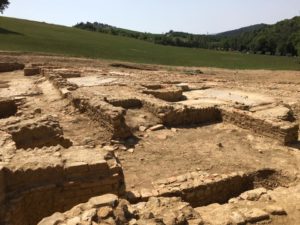
Situato nel territorio di Colle Massari, gli scavi sono iniziati nel 2012 portando alla luce una villa romana. L’insediamento di Santa Marta era sicuramente legato alla viabilità del luogo. La villa aveva pavimenti di pregio ed ambienti destinati al ricevimento. L’area è stata abbandonata in età imperiale per costruirvi un impianto termale con balnea dotati di pavimenti a mosaico e ipocausto. Nel V secolo d.C. i balnea vengono sostanzialmente abbandonati e i resti vengono spogliati del materiale edilizio, operazione che si concluse nel VII secolo d.C. Malgrado la decadenza dell’insediamento romano, il sito si trasformò in breve tempo in un insediamento ecclesiastico dipendente dalla pieve di Sant’Ippolito a Martura.
Gli archeologi, attualmente, stanno scavando l’antica pieve e, allo stesso tempo, le strutture della residenza romana, compresi i balnea, nell’area sud del complesso, accessibili tramite un cortile e un monumentale ingresso porticato.

Located in the territory of Colle Massari, the excavations began in 2012 bringing to light a Roman villa. The Santa Marta settlement was certainly linked to the viability of the place. The villa had valuable floors and rooms intended for reception. The area was abandoned during the imperial age to build a thermal bath with balnea equipped with mosaic and hypocaust floors. In the 5th century AD the bathrooms are substantially abandoned and the remains are stripped of the building material, an operation that ended in the seventh century AD. Despite the decadence of the Roman settlement, the site soon became an ecclesiastical settlement dependent on the parish church of Sant’Ippolito a Martura.
Archaeologists are currently excavating the ancient parish church and, at the same time, the structures of the Roman residence, including the balnea, in the southern area of the complex, accessible through a courtyard and a monumental porticoed entrance.

